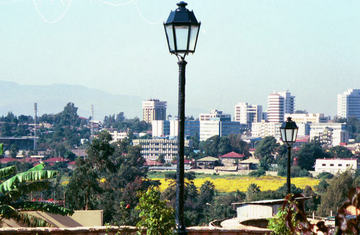 Architects want to make Addis that hosts the African Union nicer - the city has a high density of slum dwellers. (The Economist)
Architects want to make Addis that hosts the African Union nicer - the city has a high density of slum dwellers. (The Economist)
Aug 26th 2010 | ADDIS ABABA
AMHARIC has no precise word for architecture, but it needs one. Ethiopia’s capital, founded by Emperor Menelik II in 1886, now has 4.6m people but that figure may well double by 2020. Dirk Hebel of Addis Ababa’s revamped architecture school says that “the first thing we do is to sit down with the students for a day and explain what [it] is”.
According to the UN, Addis has one of the higher densities of slum dwellers in the world. But their geographical pattern is unusual. Most African cities separate fairly neatly into poor and rich areas “like a sunny-side-up egg”, with slums spreading out from the rim, says Mr Hebel. But Addis is “more of a scrambled egg”. A lack of crime and a tradition whereby the rich seem to tolerate the poor living among them mean that Addis’s slums often lie in the seams between office buildings and flats in the more affluent parts of the city.
Some cash for the overhaul of the architecture school has come from a technical institute in Zurich, known by its initials ETH. Mr Hebel and Marc Angélil, head of ETH’s architecture school, have co-written a book that explores the city’s many architectural styles. Ministries built in Ethiopia’s Marxist period (1974-91) were kit models from the Soviet Union. Fascist-style buildings built during the Italian occupation (1935-41) have often proved more suitable. Messrs Hebel and Angélil think African architects could learn from the way the Italians allowed streets to radiate out from grand central buildings.
What the architects call this “mixity” of styles may offer a chance to tackle the scourges of traffic gridlock and pollution. The city still has some open spaces that could be artfully filled in if public transport and the water supply were improved, along with the planting of indigenous trees and grasses. Read more.
—
Join the conversation on Twitter and Facebook.

























